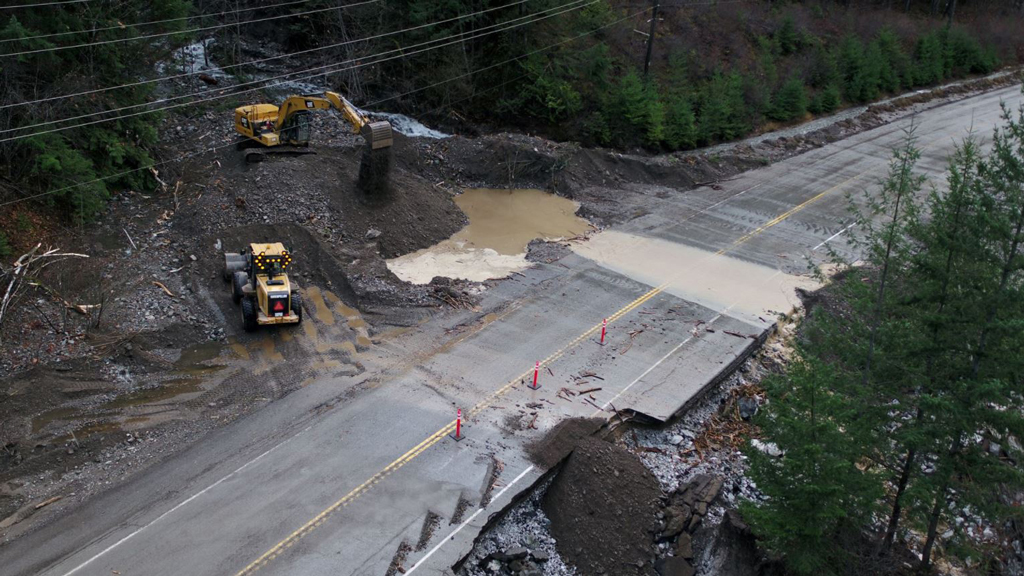B。C. is in a state of emergency as many major routes remain severely damaged by flooding and landslides and thousands are evacuated or are on evacuation alert.
The body of one person has been recovered and several people remain missing.
“Provincial, federal and local governments are working with emergency personnel to make sure people and communities get the help they need as they work through yet another natural disaster. This provincial declaration of emergency will ensure the transport of goods, and essential and emergency services,” said Premier John Horgan. “Thank you to everyone for doing what you can to stay safe and to help one another as we work through this catastrophic time.”
Chris Atchison, president of the B.C. Construction Association, said the province’s construction community is ready and to do critical infrastructure work.
“First and foremost, our collective and concerted efforts need to be directed toward the people, communities, land, livestock and infrastructure most impacted by the recent catastrophic flood damage,” said Atchison. “This new state of emergency is proof again of how crucial B.C.’s construction industry is. Whatever the crisis, resilience and recovery always comes back to B.C.’s skilled tradespeople and contractors. And when the crisis has passed, we’ll remain a big part of the solution. Pandemic, flood, fire — construction is always in the thick of it. Health care workers rush to fix people, we rush to repair and rebuild our infrastructure: the roads, pump stations and water treatment plants, schools and hospitals that we all rely on.”
State of emergency
The state of emergency is initially in effect for 14 days and may be extended or rescinded as necessary. It applies to the whole province and ensures federal, provincial and local resources can be delivered in a co-ordinated response.
“Our focus is on clearing, repairing and reopening roads to connect the Interior and the north to the Lower Mainland and Vancouver Island, to get our supply chains moving,” said Rob Fleming, minister of transportation and infrastructure. “We are working closely with multiple partners to make this happen. It is a big job, but collectively we are up to the challenge and will get things opened up again just as soon as we possibly can.”
People stranded
There are approximately 17,775 people evacuated due to impacts from the flooding, with 5,918 properties on evacuation order, and around 2,700 properties on evacuation alert.
According to the Canadian Press, Mounties said Saturday that the bodies of three men were recovered from a landslide area on Highway 99 between Lillooet and Pemberton, along a section of the route known as the Duffey Lake Road. They said the bodies were discovered over the course of last week, and that they raised the death toll from that mudslide to four. The body of a woman was recovered by crews not far away last Monday.
In the coming days, additional federal personnel and resources will be arriving in B.C. to assist. The province has also been co-ordinating with Washington State to get supplies to communities. And the Wildlife Service has been using helicopters to drop food and water.
The state of emergency gives agencies, such as the Ministry of Transportation and Infrastructure, Emergency Management BC, the RCMP and others the ability to use extraordinary measures to protect people and communities.
Reconnecting
Progress is already being made to reconnect the province’s routes.
Officials stated repairs to Highway 1 at Tunnel Hill on the Malahat have progressed well, and no further overnight closures are needed. They added repairs will continue through the weekend. While work is underway, drivers can expect single-lane alternating traffic with some intermittent closures to assist fuel tankers and emergency services through the site.
The province expects that emergency repairs should be completed by end of day Monday (Nov. 22) if the weather is good.
Crews were also able to open one lane of Highway 7 between Hope and Agassiz for commercial vehicles and about 1,000 people stranded in Hope. However, officials said after stranded people make their way home, Highway 7 will be closed again between Agassiz and Hope so crews can continue to work. Emergency services vehicles will continue to have access.
Mudslides on Highway 7 near Agassiz trapped over 300 people overnight last Sunday (Nov. 14) before they were rescued and at least nine people whose vehicles tumbled down an embankment in that area were found.
The province stated it hopes to have Highway 7 open to single-lane alternating traffic for all vehicles between Hope and Agassiz soon.
Fleming announced Highway 3 and Highway 99 may be reopened to limited traffic in the coming days as the province prioritizes the movement of essential goods and services including gas.
He added Highway 1 on Vancouver Island has been reopened to single-lane traffic and 15 fuel trucks were refilling gas stations on Nov. 18.
Merritt’s wastewater treatment plant failed during the storm and won’t be running for an “indefinite amount” of time, officials say, leaving residents without sanitary water. The city of 7,000 was ordered to evacuate.
Abbotsford, which was also forced to evacuate portions of the city, stated it urgently needs to repair its broken dikes as the forecast calls for more rain and a river in Washington state is still pushing water north.
— With files from the Canadian press
Follow the author on Twitter@RussellReports.









Recent Comments
comments for this post are closed